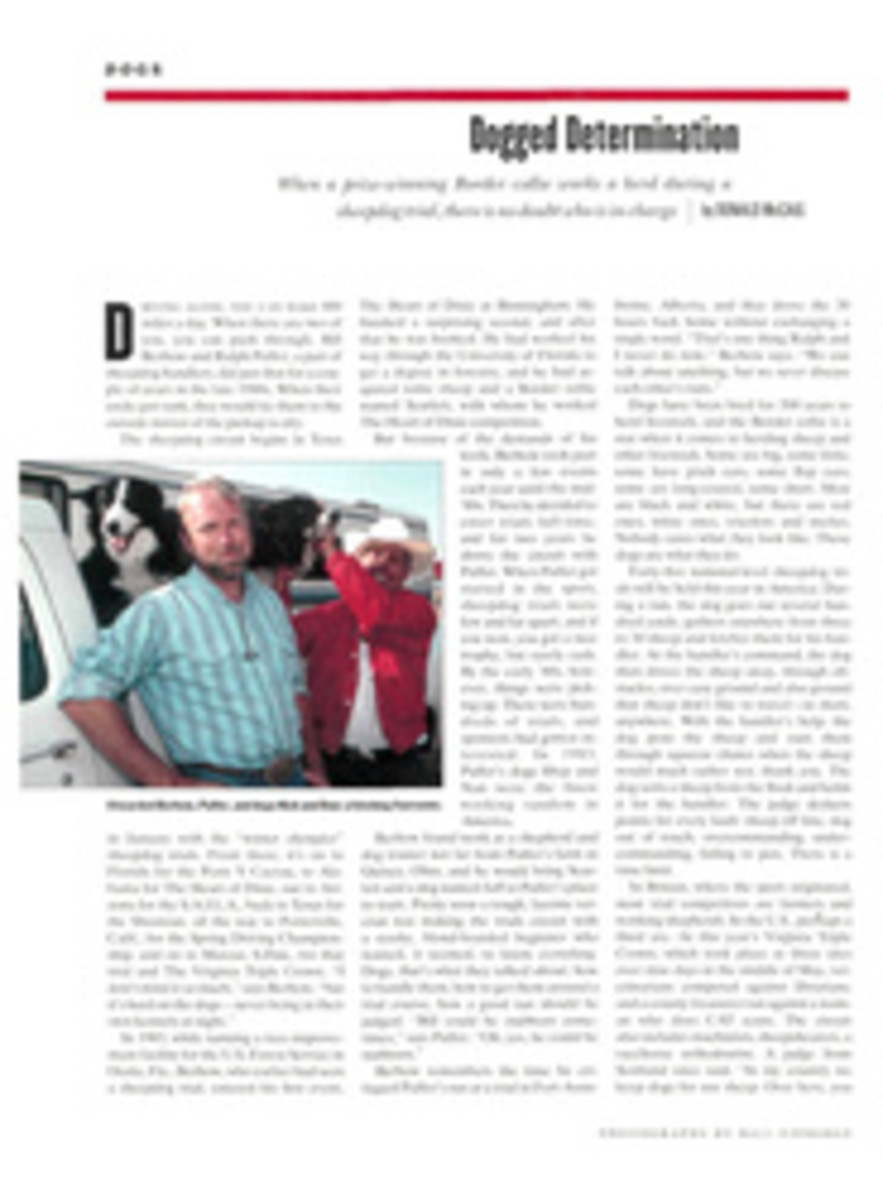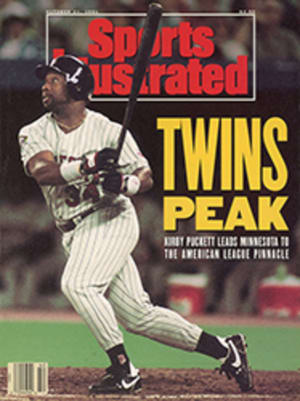
Dogged Determination
Driving alone, you can make 800 miles a day. When there are two of you, you can push through. Bill Berhow and Ralph Pulfer, a pair of sheepdog handlers, did just that for a couple of years in the late 1980s. When their socks got rank, they would tie them to the outside mirror of the pickup to dry.
The sheepdog circuit begins in Texas in January with the "winter Olympics" sheepdog trials. From there, it's on to Florida for the Penn Y Caerau, to Alabama for The Heart of Dixie, out to Arizona for the S.A.I.L.A., back to Texas for the Shootout, all the way to Porterville, Calif., for the Spring Driving Championship, and on to Marcus, S.Dak., for that trial and The Virginia Triple Crown. "I don't mind it so much," says Berhow, "but it's hard on the dogs—never being in their own kennels at night."
In 1983, while running a tree-improvement facility for the U.S. Forest Service in Ocala, Fla., Berhow, who earlier had seen a sheepdog trial, entered his first event, The Heart of Dixie at Birmingham. He finished a surprising second, and after that he was hooked. He had worked his way through the University of Florida to get a degree in forestry, and he had acquired some sheep and a Border collie named Scarlett, with whom he worked The Heart of Dixie competition.
But because of the demands of his work, Berhow took part in only a few events each year until the mid-'80s. Then he decided to enter trials full-time, and for two years he drove the circuit with Pulfer. When Pulfer got started in the sport, sheepdog trials were few and far apart, and if you won, you got a nice trophy, but rarely cash. By the early '80s, however, things were picking up. There were hundreds of trials, and sponsors had gotten interested. In 1983, Pulfer's dogs Shep and Nan were the finest working tandem in America.
Berhow found work as a shepherd and dog trainer not far from Pulfer's farm in Quincy, Ohio, and he would bring Scarlett and a dog named Jaff to Pulfer's place to train. Pretty soon a tough, laconic veteran was making the trials circuit with a stocky, blond-bearded beginner who wanted, it seemed, to know everything. Dogs, that's what they talked about: how to handle them, how to get them around a trial course, how a good run should be judged. "Bill could be stubborn sometimes," says Pulfer. "Oh, yes, he could be stubborn."
Berhow remembers the time he critiqued Pulfer's run at a trial in Fort Assiniboine, Alberta, and they drove the 30 hours back home without exchanging a single word. "That's one thing Ralph and I never do now," Berhow says. "We can talk about anything, but we never discuss each other's runs."
Dogs have been bred for 500 years to herd livestock, and the Border collie is a star when it comes to herding sheep and other livestock. Some are big, some little; some have prick ears, some flop ears; some are long-coated, some short. Most are black and white, but there are red ones, white ones, tricolors and merles. Nobody cares what they look like. These dogs are what they do.
Forty-five national-level sheepdog trials will be held this year in America. During a run, the dog goes out several hundred yards, gathers anywhere from three to 30 sheep and fetches them for his handler. At the handler's command, the dog then drives the sheep away, through obstacles, over easy ground and also ground that sheep don't like to travel—in short, anywhere. With the handler's help, the dog pens the sheep and runs them through squeeze chutes when the sheep would much rather not, thank you. The dog sorts a sheep from the flock and holds it for the handler. The judge deducts points for every fault: sheep off line, dog out of touch, overcommanding, under-commanding, failing to pen. There is a time limit.
In Britain, where the sport originated, most trial competitors are farmers and working shepherds. In the U.S., perhaps a third are. At this year's Virginia Triple Crown, which took place at three sites over nine days in the middle of May, veterinarians competed against librarians, and a county treasurer ran against a woman who does CAT scans. The circuit also includes machinists, sheepshearers, a racehorse orthodontist. A judge from Scotland once said, "In my country we keep dogs for our sheep. Over here, you keep sheep so you can work your dogs."
In either case, trialing won't make you rich. So far this year Berhow, who's 38 and now lives in Lavinia, Mont., has taken home less than $20,000 in winnings. To do it he has had to put 35,000 miles on the odometer, with another 15,000 or so to come. He's on pace to better his recent achievements; in 1989 and '90 his dog Nick won the Purina Sheep Herding Dog award (another of his dogs, Jen, came in third in '90), and last year Berhow also won the national handler's finals. In the summer of '90, Berhow had to put old Scarlett down. It was, he says, the hardest thing he has ever done.
This May in South Dakota, Berhow fell asleep at the wheel and totaled his pickup. Remarkably, Nick and Jen weren't hurt, nor was Berhow. Two days later, they jumped out of Berhow's replacement pickup, and Nick won first overall at the Blue Ridge Trial in White Post, Va., an event Berhow has taken four times.
The Blue Ridge, along with Seclusival and Oatlands, form The Virginia Triple Crown. Handlers come from as far away as Maine and Texas, Canada and Montana, to run against the cleverest dogs in North America. In the dawn fog, before each trial starts, dozens of dogs dash around, renewing old acquaintances, observing important dog rituals.
Sheepdog trialing is a three-species sport, and the best human and dog cannot win if they've drawn the worst sheep. Trial organizers try to ensure that sheep come out even, but sheep that were quicksilver in the morning may be sulky at noon. Sometimes a handler draws a crazy sheep, one who never heard of "the sheep-flocking instinct," who takes off for the tall timber. Sometimes a sheep will fight the dog and need to be backed around the course, one reluctant hoof at a time.
"Bill's very cool," says handler Bev Lambert. "He doesn't run to place. If you're going to win, you can't play the odds. The coolest thing I ever saw Bill do was at a trial when he had only seven seconds to get his shed [separate the sheep]. He took time to settle the sheep before he called his dog in. You have to have a lot of confidence in yourself and your dog to do that."
Nick, a seven-year-old, has won more than 50 trials. He is a stocky, hearty, mostly black dog with a white blaze, tail tip, paws and spot on his neck. "Nick's got a happy attitude," says Berhow. "If he was a person, he'd always have a new joke. He'd say 'Good morning' if there was nothing but thunder and lightning."
Near the close of last season, Jen, who's an eight-year-old bitch, became sick of the endless trialing and traveling and developed a serious case of the sulks. Berhow took her home and did nothing. "You just have to leave her until she comes back to it," he says. Jen came back to win the overall title at this year's Seclusival trial; she was more than ready for Oatlands.
Oatlands is held at a National Trust plantation, outside Washington. Thousands of urban spectators come for a quiet day in the country, or to wonder at dogs doing things they never dreamed dogs could do. On the course, Lambert whistled her dog through the run with signals: "Go right," "Stop," "Right," "More right," "Stop," "Walk up," "Stop," "Lark, lie down." The commands were as quick as birdcalls, as fast as one per second.
Berhow awaited his turn with Jen. As they walked out to the handler's post, side by side, other handlers leaned forward in their lawn chairs and stopped talking. Berhow stood calmly at the post, conversing with Jen. Suddenly, she was away.
There was a great mob of spectators, kids kicking up a ruckus, a piper playing Highland folk tunes, but Berhow was deaf to all that as Jen went out 100 yards, 200, 300, behind the sheep. They came off nicely, and Berhow whistled Jen left, right, balancing the herd. The sheep came to Berhow's feet and moved around him, Jen's feet thudding on the hard ground as she raced around on the outside of the herd to start the drive to the first set of gates. The sheep were through one set, and it looked as if Berhow had waited too long to tell Jen to hook back in so that she could catch the sheep at the second set of gates. But no, Jen was dead right, and the sheep trotted through these gates, too, and into the shedding ring, where the dog had to cut out two sheep. She did it perfectly.
The sheep balked at the pen. Sheep may not be brilliant, but they know that sheep in pen is stage number one of lamb chops. One sly ewe tried to sneak around the pen, but Jen headed her off. She tried again, time ticking away, and suddenly the sheep gave up and went into the pen.
Berhow and Jen hurried back to the shedding ring, where this time they had to cut out a single sheep. The first time an opening appeared in the flock, Berhow failed to call Jen through it to cut off a lone sheep. However, he called her in the next time, and she came through and faced her single. Though the sheep stamped and pawed, dodged and threatened, Jen got the upper hand. The judge cried, "That'll do!" and the crowd applauded. Berhow bent to give Jen a pat before doffing his cap to the spectators, and the two retired to the end of the course, where Jen flopped into a tub of cool water.
On this day Berhow and Jen finished third. Before heading to the following week's trial in Pittsboro, N.C., Berhow put his special world into perspective. "You only get one chance," he said, "to follow your passion."
PHOTO
BILL EPPRIDGE
A bearded Berhow, Pulfer, and dogs Nick and Dan: a fetching foursome.
TWO PHOTOS
BILL EPPRIDGE
During a trial, a dog must make sheep go places they would prefer not to go, thereby earning a rest and a look at the competition.
Donald McCaig's most recent book is the non-fiction "Eminent Dogs, Dangerous Men."

